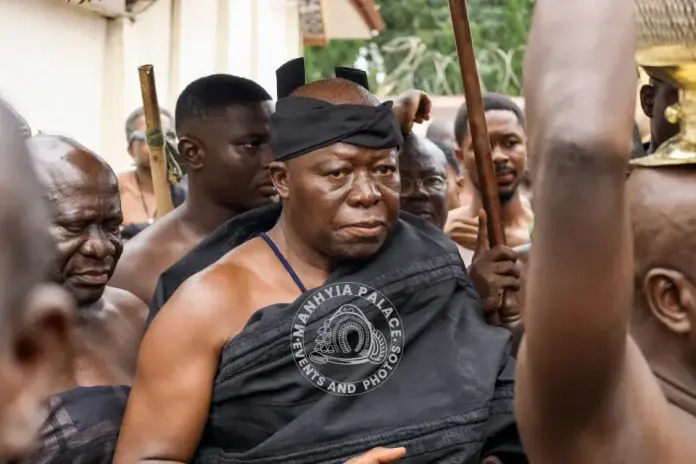By Ghana News
Copyright ghanamma

The final funeral rites for the late Asantehemaa Nana Konadu Yiadom III created an unexpected economic boom across Kumasi, transforming Ghana’s Garden City into the nation’s busiest marketplace despite the somber mourning atmosphere that engulfed the Ashanti capital.
The four-day burial rites, known locally as Doteyie, drew thousands of mourners from across Ghana and beyond to the Manhyia Palace, creating unprecedented demand for goods and services that generated substantial revenue streams for local businesses.
While the entire Kumasi metropolis initially went silent and brought all economic activities to a halt due to strict compliance by residents, particularly at the usually busy Adum and Kejetia markets, the massive influx of visitors quickly transformed the economic landscape into what industry observers described as a cultural tourism goldmine.
Traditional black cloth, locally called kuntunkuni, became the most sought-after commodity as mourners and visitors scrambled for appropriate funeral attire. Traders at Kejetia and Adum markets reported record-breaking sales, with prices increasing significantly as demand outstripped supply throughout the four-day ceremony.
The unusual economic dynamics extended to barbering services, which experienced unprecedented demand as traditional protocol required many women to adopt the “dansikran” haircut, where hair is shaved and darkened as a mark of respect. Barbershops operated around the clock, with some operators charging premium rates for express services.
Food vendors capitalized on the massive crowd, with demand for local delicacies including fufu, waakye, and roasted plantain reaching extraordinary levels. Vendors near the Manhyia Palace reported continuous sales throughout the ceremony, while catering services secured lucrative contracts for official funeral events.
The transportation sector witnessed what industry players described as a “cocoa season,” with bus terminals overflowing and fares increasing substantially. Airlines reported domestic flights to Kumasi being fully booked days in advance as visitors from Accra, Tamale, Takoradi, and international destinations rushed to witness the historic ceremony.
Accommodation facilities experienced full capacity as hotels and guest houses recorded significant occupancy increases. Tailors worked continuously to produce black funeral attire, while photographers, videographers, and mobile money agents reported substantial business increases during the mourning period.
The economic sacrifice demonstrated significant cultural reverence in a nation with a Gross Domestic Product (GDP) per capita of around $2,500, highlighting the complex trade-offs that accompany traditional honor, according to recent analysis of the funeral’s economic impact.
The spectacle revealed Ghana’s potential for funeral tourism, with the beautiful cultural displays, historical significance, and traditional ceremonies attracting not just mourners but curious tourists interested in experiencing authentic Ghanaian heritage.
This phenomenon aligns with broader cultural tourism trends in Ghana, where FESTAC Africa 2025, scheduled for September 21-27 in Accra, aims to transform artistic expression into strategic economic impact, with over 100,000 attendees expected to stimulate the local economy through tourism, hospitality, and entertainment services.
Funeral tourism has been gaining popularity in Ghana, suggesting growing recognition of these ceremonies’ economic potential beyond their primary cultural and spiritual purposes.
The Asantehemaa’s funeral demonstrated how deeply intertwined Ghana’s cultural traditions are with economic opportunities, proving that even during periods of mourning, business activities can thrive when properly channeled through cultural authenticity and tourist interest.
Industry experts suggest the economic windfall represents a template for leveraging Ghana’s rich cultural heritage as tourism drivers, particularly given the increasing global interest in authentic African cultural experiences and traditional ceremonies.
In Ghanaian culture, the journey from life to death is perceived not as an ending, but as a transition into the ancestral realm, representing a natural phenomenon within the cycle of existence, which helps explain the elaborate nature of funeral celebrations and their economic significance.
The success of the Doteyie as an economic generator suggests policymakers should consider funerals not merely as cultural obligations but as potential engines for economic growth, particularly within the tourism sector that seeks authentic cultural experiences.
With proper planning, branding, and investment, Ghana could systematically develop cultural spectacles into deliberate tourism products, attracting international visitors eager to witness the grandeur of Asante traditions and other rich cultural heritage expressions across the country.
The economic impact extended beyond immediate sales to demonstrate the multiplier effect of cultural events on local economies, creating employment opportunities, boosting supply chains, and generating tax revenue for local authorities during the ceremonial period.
Analysis of the funeral’s economic impact reveals the untapped potential of Ghana’s cultural tourism sector, where traditional ceremonies could become significant foreign exchange earners while preserving and promoting cultural heritage for future generations.
The late Asantehemaa’s Doteyie ultimately revealed how grief and commerce can coexist productively, providing a blueprint for transforming cultural obligations into economic opportunities that benefit entire communities while maintaining the dignity and authenticity of traditional practices.



